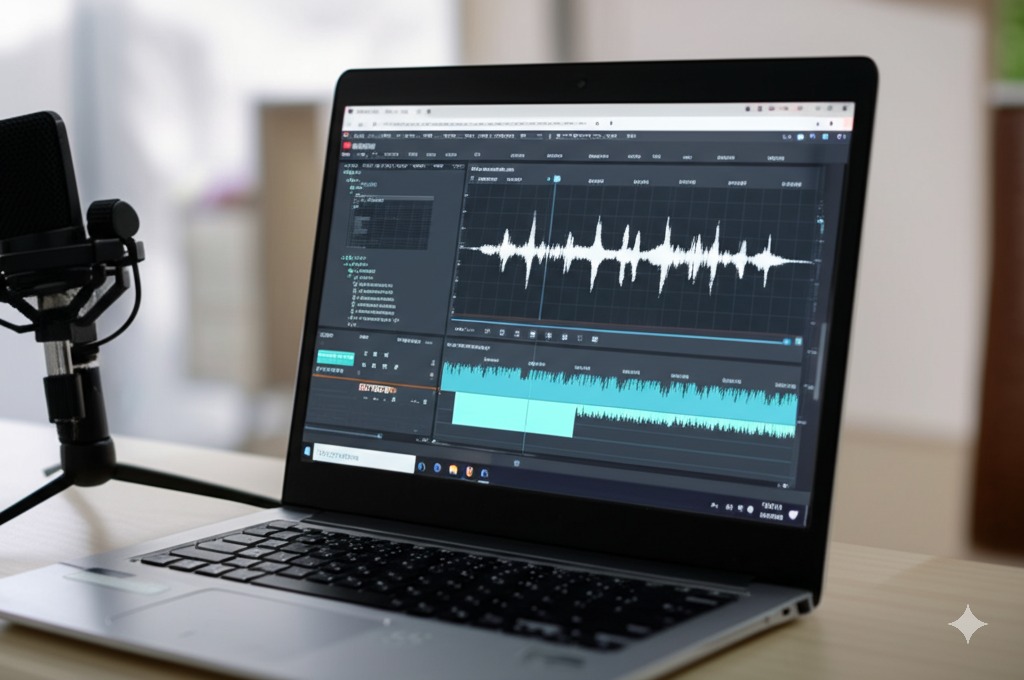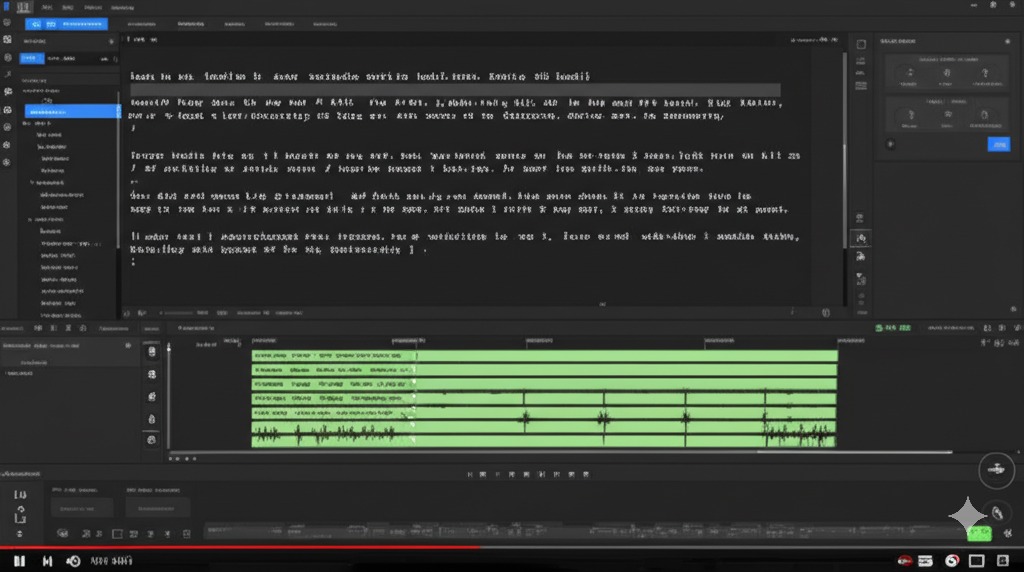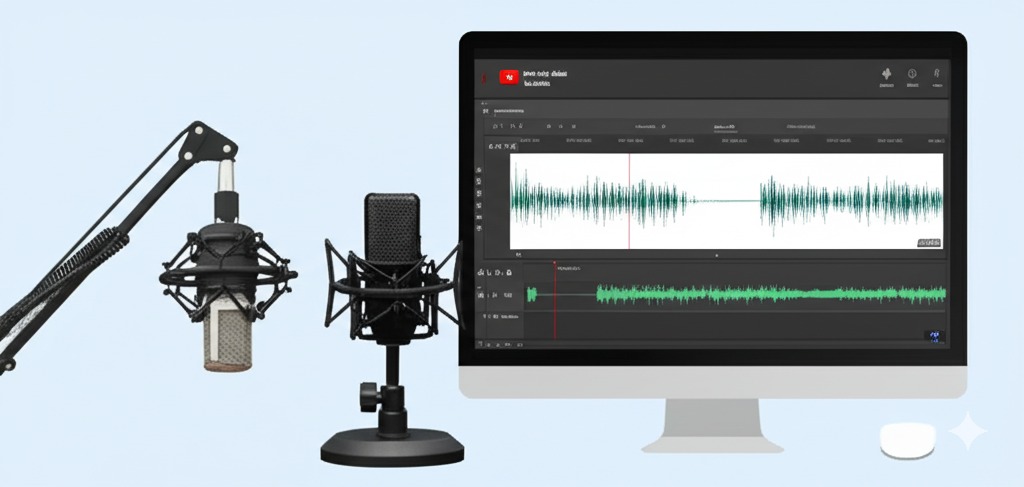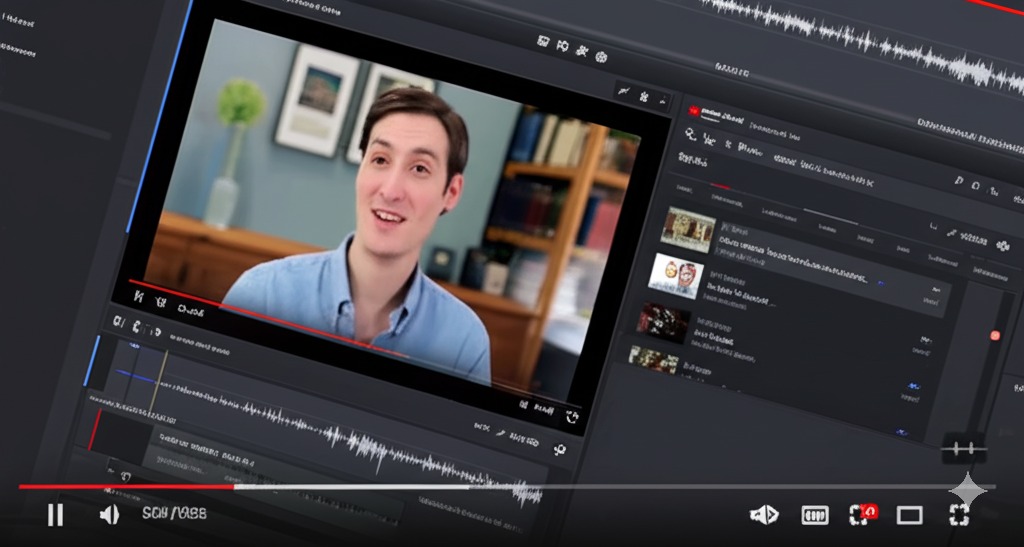
If you’re looking for free text to voice for YouTube, the best options are Fliki.AI, Murf.ai, and Lovo.ai. These AI-powered tools generate realistic, human-like voiceovers that enhance your videos without costing a dime. They help creators sound professional effortlessly, and I’ve tested them myself—your content will never be the same!
Introduction
Many YouTube creators feel anxious about narrating their own videos, but thanks to advanced free text to voice for YouTube technology, you don’t have to. These AI-powered solutions have made it incredibly simple to create smooth, natural-sounding narrations without spending a dime.
In this comprehensive guide, we’ll walk you through the best no-cost options to convert your scripts into polished voiceovers. Whether you’re looking to save precious time, maintain voice consistency across your channel, or connect with viewers worldwide, these free tools offer everything you need to elevate your YouTube content.

How Text to Voice Technology Has Changed for Video Content
Remember computer voices from the 90s? They sounded like robots reading from a script. Today’s AI narration for YouTube videos sounds surprisingly human thanks to major advances in technology.
Modern AI voices can add emotion, adjust pacing naturally, and even include breathing sounds between sentences. They understand context better too, so they don’t mix up words that look the same but sound different.
What changed? Tech companies trained their AI on thousands of hours of real human speech. Now these tools can express excitement, pause naturally, and handle difficult words correctly. For YouTube creators, this means viewers might not even notice you’re using AI voices at all.
Why Content Creators Are Switching to Text to Voice
So why are more creators using free AI voiceover software for their YouTube videos? The advantages are pretty compelling.
Save Time and Energy
Creating a good voiceover the traditional way takes time. You need a quiet room, decent equipment, and usually multiple takes to get it right. With text to voice technology, you just type your script, make a few adjustments, and you’re done. This can cut your production time by hours, especially if you’re not comfortable with voice recording. Many creators who used to spend a full day on audio now finish in under an hour. Think about what you could do with all that extra time – more research, better visuals, or more videos.
Sound Consistent in Every Video
Human voices change depending on time of day, health, and even what you ate. A virtual narrator for YouTube delivers the same quality every time. This consistency helps build a recognizable brand for your channel.
Reach Global Audiences
Want viewers who speak different languages? Good text to voice tools can translate your script and create voiceovers in multiple languages without you speaking a word of them. This can massively expand your potential audience.
Overcome Voice Limitations
Not everyone has a voice suited for narration. Some people have health conditions or speech difficulties that make recording challenging. Text to voice makes content creation accessible to more creators.
Save Money
Professional voice actors can charge hundreds or even thousands of dollars. Text to speech voice generators let you create professional-sounding narration without that expense.
Top Free Text to Voice Tools for YouTube
Here are the best tools you can start using right away to create quality voiceovers for your videos.
Fliki.AI – Best All-Around Option
Fliki.AI offers a great balance of quality and ease of use. Their free plan gives you access to over 30 realistic AI voices in multiple languages with a straightforward interface – paste your script, pick a voice, and download.
What makes Fliki stand out is how they’ve designed voices for specific content types like education, corporate videos, and entertainment. The free plan has some usage limits, but it’s enough to create several videos before deciding if you want to upgrade.
Fliki also offers specialized templates for different content types and translation capabilities that let you easily create multi-language versions of your videos.
Murf.ai – Best Voice Controls
Murf.ai provides some of the most natural-sounding voices available. The standout feature is the level of control you get – adjust pace, pitch, emphasis, and even add breathing sounds between phrases.
With the free plan, you get 10 minutes of voice generation each month and access to some premium voices. That’s enough for a couple of short videos. Their editor lets you hear changes instantly as you adjust settings.
Murf also offers a team workspace feature. If you’ve got someone else handling your scripts or you’re making videos with friends, everyone can collaborate in one place. No more sending script files back and forth over email!
Lovo.ai – Best Voice Selection
Lovo.ai is like the ice cream shop with 100 flavors. Their free plan includes over 100 different voices across 33 languages. This is perfect if you’re still figuring out what voice fits your channel or if you need different character voices for your content.
The coolest thing about Lovo is their voice blending feature. Even on the free plan, you can mix existing voices to create something unique. It’s like making your own custom voice without paying for the premium voice cloning option.
You get 20 minutes of voice generation per month with their standard voices, which is pretty generous for a free tool. Their interface is straightforward – you won’t need a tech degree to figure it out.
Play.HT – Most Natural Sound
If you’re after the most human-sounding voices, check out Play.HT. Their free plan is smaller – about 2,500 characters monthly (roughly a 2-3 minute voiceover) – but the quality is impressive.
The standout feature is the control you get. Their SSML support (Speech Synthesis Markup Language) lets you fine-tune exactly how the voice speaks. Want a thoughtful pause? A breath between sentences? Emphasis on a key word? You can do all that without paying.
They even have a Chrome extension that turns any text on the web into speech – handy when researching content or brainstorming script ideas.
VoiceOverMaker.io – Best for Editing
VoiceOverMaker.io doesn’t offer as many voice options, but it makes up for that with useful editing tools. Their free plan includes a multi-track editor where you can layer your voiceover with music and sound effects all in one place.
The standout feature here is how easily it helps you sync your voiceover with your video timeline. Anyone who’s spent hours trying to get narration to match visuals perfectly will appreciate how much time this saves. The free plan gives you 30 minutes of voice generation monthly.
Another big plus? It automatically generates captions from your voiceover – one less step in your workflow.
Creating Professional-Sounding YouTube Voiceovers

Having great tools is just the starting point. To create voiceovers that actually sound professional, you need to know a few tricks.
Writing Scripts for AI Voices
Even the best AI voices need well-written scripts to sound natural:
- Use punctuation as your director. Commas create short pauses, periods create longer ones. Add extra commas where you want natural pauses.
- When the AI messes up numbers or dates, spell them out. “Twenty twenty-three” usually works better than “2023” if you’re having pronunciation issues.
- Test tricky words and names. If the AI pronounces something wrong, try different spellings to fix it. Sometimes “Techknowledgy” works better than “Technology” for pronunciation.
- Use shorter sentences. They sound more natural and reduce the risk of the AI emphasizing the wrong words.
- For unusual terms, add phonetic spelling in parentheses if needed.
Remember that writing for listening is different from writing for reading. Try reading your script aloud before using the AI to catch awkward phrases.
Voice Customization Tips
Make the most of customization options available in free tools:
- Adjust speaking rate to match your content. Educational videos often benefit from a slightly slower pace.
- Use pitch changes sparingly. A slight increase can add enthusiasm, while a slight decrease can add authority.
- Add strategic pauses between sections to let important points sink in.
- If available, add breathing sounds between major sections for a more natural human feel.
- Test different emphasis patterns on key points. Emphasizing different words can completely change a sentence’s impact.
Try creating 2-3 versions with different settings, then compare them to see which sounds most natural for your content.
Syncing Voiceovers with Video
Getting your voiceover perfectly matched with your visuals makes your video feel much more professional:
- Create your voiceover before finalizing your video edit. It’s easier to match visuals to audio than vice versa.
- Break your script into smaller sections rather than one long file. This makes it easier to place each part exactly where you want it.
- Use visual transitions to hide any awkward pauses or timing issues.
- If your voiceover runs too long for a section, slightly increase the speed rather than cutting content.
- For scenes requiring precise timing, add extra pauses in your script to give yourself editing flexibility.
Good sync between words and visuals creates a more engaging experience for viewers, which can improve your retention rates.
Choosing the Right Voice for Maximum YouTube Engagement
The voice you choose can significantly impact how viewers engage with your content. This is where YouTube AI voice generator tools give you an advantage.
How Voice Selection Affects Viewer Retention
Research shows different voice characteristics affect how long viewers watch your videos:
- Voice gender preferences vary by topic. Tech tutorials often perform better with male voices, while wellness content often does better with female voices. But this isn’t universal – testing is important.
- Accent matters. Using an accent similar to your target audience often improves engagement. Some accents (like British) often perform well globally for educational content.
- Pace affects understanding and engagement. Faster voices (about 150-160 words per minute) work well for entertainment, while educational content benefits from a slightly slower pace.
- The perceived age of the voice affects credibility. Younger-sounding voices often connect better with younger audiences, while mature voices convey more authority for complex topics.
These are generalizations – your specific audience might prefer something different, which is why testing is important.
Voice Selection for Better Algorithm Performance
YouTube’s algorithm rewards audience retention and engagement. Here’s how to optimize your voice selection:
- Use a consistent voice across your channel to build familiarity with viewers.
- Match energy levels to content type. Higher-energy voices work better for shorter videos, while calmer tones work better for longer, detailed content.
- Use appropriate voices for your topic. Authoritative voices work well for instructional content, while warmer voices excel for entertainment.
- Pay attention to pacing in sections where viewers typically drop off.
- Use the highest quality rendering options available in your free tier.
By choosing voices that encourage longer watch times and higher engagement, you can improve your channel’s performance.
How to Test Different Voices
Not sure which voice works best? Try this simple test:
- Create two versions of the same video with different AI voices.
- Upload them at the same time with identical titles, descriptions, tags, and thumbnails.
- After both videos have enough views (at least 500 if possible), compare:
- Average view duration
- Audience retention graphs
- Engagement (likes, comments)
- Click-through rate
- Use these findings for future videos.
You can test different elements: male vs. female voices, different accents, energy levels, or speaking rates. These tests will help you find the perfect voice for your audience.
Success Stories: Free Text to Voice in Action
Let’s look at how different types of channels are using free text to voice for YouTube to grow their audiences.
Educational Channels
Educational channels were early adopters of text to voice technology. Khan Academy used AI narration for supplementary content, allowing them to produce more tutorials without requiring their founder to record everything.
Many tutorial channels find that AI voices can improve clarity for complex topics. The consistent pacing and clear pronunciation help viewers follow technical instructions, especially for software tutorials.
One math tutorial channel doubled their subscribers within six months after switching to AI narration. They produced three times as many videos, and the clear narration actually reduced confusion in the comments.

Commentary and News Channels
News and commentary channels use text to voice tools to produce content quickly. In niches where being first to cover a topic matters, removing recording time gives channels an edge.
Many successful channels use AI voices for presenting news and human voices for analysis sections. This plays to the strengths of both approaches – AI for clear delivery of facts, and human voices for opinion.
One tech news channel increased from two videos weekly to daily content after implementing text to voice, growing monthly views by 340% in just three months.
Entertainment and Storytelling
Fiction channels use different AI voices for different characters, creating engaging narratives without needing multiple voice actors.
Animation channels often use text to voice during development, then either keep it or replace it with human voices later. This streamlines production significantly.
A horror story channel uses AI voices intentionally for their slightly uncanny quality, which enhances the creepy atmosphere. This unique approach built them a dedicated audience of over 100,000 subscribers.
Multilingual Content
Perhaps the most powerful application is creating content in multiple languages. Channels that once reached only English speakers can now create versions in Spanish, French, German, and many other languages.
A travel channel increased their viewership by 320% after creating Spanish and Portuguese versions of their popular videos. The translated versions required minimal additional work but reached entirely new audiences.
Educational content particularly benefits from this approach, as specialized information can reach global audiences without the creator speaking multiple languages.

Check out all the text-to-video and text-to-speech use-cases offered by Fliki.
- Content Creation: YouTube videos, Instagram Reels, TikTok, podcasts, audiobooks
- Business and Corporate: Corporate videos, pitch videos, product demos, slideshows
- Training Videos: Employee onboarding, product training, leadership development
- Internal Communication: Team announcements, company updates, employee engagement
- Marketing and Social Media: Promo videos, video ads, social media content
- Education and E-Learning: Educational videos, training videos, explainer videos
- eCommerce: Product explainers, product marketing
- Localization and Translation: Seamlessly transform your script into over 80 languages
Advanced Techniques for Better AI Narration
These advanced techniques can help you create even more engaging content using synthetic speech for content creation.
Using SSML for Better Control
Speech Synthesis Markup Language (SSML) is like HTML but for speech. It gives you precise control over how text is spoken. Even basic SSML can dramatically improve your voiceovers:
Copy
<speak>
Welcome to my channel!
<break time=”1s”/>
<emphasis level=”moderate”>Today</emphasis> we’re going to explore something amazing.
<prosody rate=”slow” pitch=”+10%”>This is really important</prosody> so listen carefully.
</speak>
This adds a one-second pause after the greeting, emphasizes “Today,” and slows down the “This is really important” phrase while slightly raising the pitch.
Not all free tools support full SSML, but Play.HT and Murf.ai offer good support in their free plans.
Using Multiple Voices Creatively
Using multiple voices can transform your content from simple narration to something more engaging:
- Create interview-style content with different voices for interviewer and guest.
- Use different voices for setting the scene versus delivering key information.
- Use a different voice for summaries or key takeaways.
- Create character-driven content with distinct voices for each role.
The key is consistency – once you assign a voice to a specific function or character, keep it consistent throughout your videos.
Adding Music and Sound Effects
The right background elements can transform good AI narration into great content:
- Use background music at 10-15% of your narration volume to fill space without competing with the voice.
- Match music to your content’s emotional tone – upbeat for positive topics, more serious for educational content.
- Add subtle sound effects to emphasize key points or transitions.
- Lower music volume during important information and raise it during transitions.
- Add relevant ambient sounds (keyboard typing for tech tutorials, nature sounds for outdoor content).
Remember that audio elements should enhance, not distract from, your narration.
Creating a Consistent Voice Brand
Just like visual branding, voice branding creates audio recognition:
- Select a primary voice for your channel and use it consistently.
- Document your voice settings (pace, pitch, emphasis patterns) so you can replicate them exactly.
- Create a standard introduction phrase that begins each video the same way.
- If using multiple voices, assign specific roles to each and maintain those roles.
- Develop voice-specific catchphrases or transitions that viewers will recognize.
This consistency builds familiarity and trust with your audience, making your content instantly recognizable.
Frequently Asked Questions about Free Text to Voice for YouTube
Let’s address common questions about using voice synthesizer for video content tools.
Can Videos with AI Voices Be Monetized?
Yes, YouTube allows monetization of content with AI-generated voices. What matters is the originality of your content, not whether you used AI for the voiceover.
Just make sure you:
- Have proper licenses for the AI voices you use (most free tools allow commercial use, but check terms)
- Meet all other YouTube monetization requirements
- Create original, valuable content
Many successful monetized channels use AI voices either exclusively or for portions of their content.

How Do Viewers React to AI Voices?
Research shows that viewer response to AI voices has improved dramatically:
- Most viewers under 35 can’t reliably tell the difference between good AI voices and human narration in blind tests
- Comment sentiment analysis shows neutral to positive reactions to AI voices
- Retention rates for content with quality AI narration are similar to human narration
- Many viewers actually prefer the clarity and consistent pacing of AI voices for tutorials
Quality matters – premium AI voices from tools like Murf.ai and Lovo.ai get much better responses than older, robotic-sounding options.
Tips for Natural-Sounding AI Narration
Want your artificial voice generator to sound as human as possible? Try these techniques:
- Break long scripts into natural paragraphs instead of feeding the AI one big text block
- Add strategic pauses and breathing sounds between topics
- Use contractions (don’t, can’t, we’re) like in natural speech
- Vary sentence length and structure to avoid monotony
- Include occasional filler words very sparingly for a conversational feel
- Add emphasis to important words
- Consider recording a personal introduction yourself and using AI for the main content
- Adjust speed to match natural human pace (140-170 words per minute)
- Use punctuation for natural speech patterns, not just grammar
The goal isn’t to trick viewers but to create a pleasant listening experience that doesn’t distract from your content.
Legal Considerations
When using text to voice for content creators tools, be aware of these legal issues:
- Terms of Service: Read the terms carefully – some free tiers restrict commercial use
- Copyright: You typically don’t own the AI voice itself, just the audio files you generate
- Disclosure: Some platforms may require disclosure when AI voices are used
- Impersonation: Never use AI voices to impersonate real people without permission
- Content Ownership: You own your script, but the voice pattern belongs to the service provider
Most reputable tools permit YouTube use in their free plans, but always verify before building your channel around a specific voice.
How to Create YouTube Videos with Text to Voice for Free
Let’s put everything together with a practical workflow for creating YouTube videos using free text to voice tools.
Step 1: Write Your Script
- Write conversationally, as if talking to a friend
- Break into short paragraphs (2-3 sentences) for better pacing
- Read aloud to catch awkward phrasing
- Add punctuation strategically for natural pacing
- Mark words needing emphasis
Step 2: Generate Your Voiceover
- Choose a voice matching your content tone and audience
- Test a short segment first to check pronunciation
- Adjust settings based on your test
- For longer content, generate separate sections
- Use clear naming for your files
Step 3: Refine the Audio
- Add short pauses between major sections
- Make sure volume is consistent throughout
- Add subtle background music if desired
- Export as high-quality audio
Step 4: Create Your Video
- Prepare your visuals (slides, footage, animations)
- Import audio and visuals into your editing software
- Sync visuals with your narration
- Add text highlights for key points
- Create captions using your script
Step 5: Publish and Optimize
- Upload with keyword-rich title, description, and tags
- Create an engaging thumbnail
- Add end screens and cards to encourage engagement
- Respond to early comments
- Track performance to improve future videos
This workflow can cut your production time by 50% or more compared to recording yourself, while maintaining professional quality.
Future Trends in Text to Voice for YouTube
What’s coming next for YouTube audio narration tools? Several exciting developments are on the horizon:
More Emotional Intelligence
Next-generation AI voices are being trained to understand emotional context and respond appropriately. Soon, free tools will likely offer voices that can express excitement, concern, humor, and other emotions based on your script.
This will make AI narration even more natural and engaging without requiring manual adjustments.
Custom Voice Options
While voice cloning is currently premium-only, we’ll likely see more accessible options for creating custom voices soon. This might include blending existing voices or training AI on short samples to create unique voices.
For creators, this means having a consistent, personalized voice without recording everything yourself.
Better Translation and Dubbing
As machine translation improves, more tools will offer instant translation and voice generation in multiple languages. This will make global content distribution even easier.
Some services are already working on matching lip movements to translated audio for more natural dubbing.
Integration with Video Editors
Expect deeper integration between text to speech voice generators and popular video editing software. This might include plugins for generating and editing voiceovers directly within your editing timeline.
These integrations will likely include automatic synchronization between visuals and generated speech.

Creating YouTube Content That Performs Well with AI Voices
Let’s finish with some strategic advice on using free text to voice for YouTube to boost your channel’s performance.
Consistency Helps Algorithm Performance
YouTube rewards channels that publish regularly and maintain viewer engagement. AI voices make it easier to stick to a publishing schedule even when you’re busy.
Many successful channels using AI voices publish 2-3 times weekly – much easier than with traditional recording. This consistency signals to the algorithm that your channel is active and engaging.
Focus on Viewer Retention
YouTube prioritizes content that keeps viewers watching. Here’s how to use AI narration to improve retention:
- Use strategic pacing – slow down for complex information, maintain a slightly faster pace for general content
- Structure content with clear sections and transitions
- Use emphasis on key points to maintain attention
- Check audience retention graphs and adjust narration in sections where viewers typically leave
Optimize for Search and Discovery
Your voice choice affects SEO in several ways:
- Clear pronunciation helps YouTube’s automatic captioning system accurately transcribe your content
- Consistent voice branding helps returning viewers quickly recognize your content
- Appropriate pacing gives viewers time to engage (like, comment, subscribe)
- Multilingual versions can help your content appear in search results across different languages
Building Community While Using AI Voices
One concern about AI narration is losing personal connection with your audience. Here are ways to maintain that connection:
- Be transparent about using AI narration
- Consider recording personal introductions yourself, while using AI for main content
- Stay active in comments to maintain the human element
- Use consistent voice branding so viewers develop familiarity with your AI voice
- Occasionally appear on camera to establish face-to-face connection
Conclusion about Free Text to Voice for YouTube
Free text to voice for YouTube tools have transformed content creation, making it more accessible and efficient. From educational creators producing more valuable content to entertainment channels creating engaging character-driven narratives, this technology offers opportunities for creators at all levels.
The key to success is using these tools strategically – selecting voices that connect with your audience, optimizing scripts for natural narration, and combining AI voiceovers with compelling visuals and valuable content.
As AI voice technology continues to improve, the line between human and synthetic narration will blur further. What won’t change is the need for authentic, valuable content that connects with viewers and solves their problems or entertains them effectively.
Whether you’re just starting your YouTube journey or scaling an existing channel, text to voice tools offer a practical way to create professional, engaging content that performs well without breaking your budget.
Ready to get started? Pick one of the free tools covered here, write a simple script, and experiment with different voices and settings. You might be surprised at how quickly you can create professional-sounding narration that helps your channel grow.
Have you had experiences with text to voice tools for YouTube content? Share them in the comments below!

